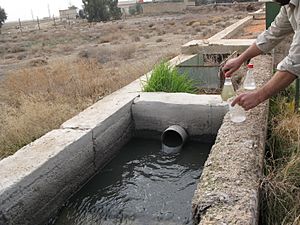Sewage facts for kids
Sewage is the dirty water that goes down our drains. It comes from many places in our homes. When you flush the toilet, take a bath or shower, or wash clothes and dishes, you create sewage. In some areas, rainwater from roofs and roads also mixes with it. Big towns and cities might also have liquid waste from factories in their sewage.
This dirty water flows through a network of pipes called sewers. These sewers carry the sewage to a special place called a sewage treatment works. Here, the sewage is cleaned up before it can go back into the environment.
Sewage is mostly water. However, it also contains many tiny living things called microbes. Some of these microbes can be harmful to people and animals. Sewage can also have many different chemicals in it. These chemicals can also cause harm if they are not removed.
Contents
Why We Clean Sewage
Cleaning sewage is very important for our health and the environment. If dirty water is released without treatment, it can spread diseases. It can also harm plants, animals, and fish in rivers and oceans.
How Sewage Gets Cleaned
Sewage treatment plants work hard to clean this dirty water. They use several steps to remove harmful things.
First Steps: Removing Big Stuff
When sewage first arrives at a treatment plant, it goes through screens. These screens are like big filters. They catch larger items that shouldn't be there. This includes things like rags, plastic, and other trash. This step protects the machinery in the plant.
Next Steps: Settling and Filtering
After the big items are removed, the sewage goes into large tanks. Here, the solid parts of the sewage sink to the bottom. This process is called settling. The cleaner water then moves to the next stage. Sometimes, special filters are used to remove even smaller particles.
Using Microbes to Help
In the next stage, helpful microbes are put into the water. These tiny living things eat the pollution in the sewage. They break down harmful substances into simpler, safer forms. This is a natural way to clean the water.
Final Cleaning and Release
After the microbes have done their job, the water is often disinfected. This might involve using chemicals like chlorine or ultraviolet light. This step kills any remaining harmful germs. Once the water is clean enough, it is safely released back into rivers or the ocean.
Images for kids
-
Pumping station lifting sewage to the treatment plant in Bujumbura, Burundi
-
Screening of the sewage with bar screens at a sewage treatment plant to remove larger objects in Norton, Zimbabwe
-
Screening of sewage at a sewage treatment plant in Bujumbura, Burundi
-
Lack of maintenance is causing sewage to overflow from a manhole into the street of an informal settlement near Cape Town, South Africa.
-
Ocean outfall pipes in Cape May, New Jersey, United States – pipes exposed after the sand was removed by severe storm
See also
 In Spanish: Aguas residuales para niños
In Spanish: Aguas residuales para niños








